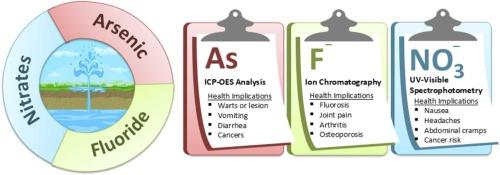A comprehensive analysis of the impact of arsenic, fluoride, and nitrate–nitrite dynamics on groundwater quality and its health implications
IF 11.3
1区 环境科学与生态学
Q1 ENGINEERING, ENVIRONMENTAL
引用次数: 0
Abstract
Groundwater contamination is a growing global concern. The objective of the present study is to assess the groundwater quality of Khairpur district, Sindh, Pakistan—a region which is emblematic of broad environmental and public health challenges prevalent in South Asian countries. The study also aims to comprehend the impact of arsenic (As), fluoride (F-), and nitrate (NO3-) dynamics and its health implications. Additionally, this work is vital in shaping the policies of higher authorities to take actions regarding public health. The American Society for Testing and Materials (ASTM) methods and modern analytical techniques, such as Inductively Coupled Plasma – Optical Emission Spectroscopy (ICP-OES), Ion Chromatography (IC), and UV-Vis Spectrophotometry were employed to analyze a series of groundwater samples (n = 50), taken from various locations of Khairpur district. Present study reveals a high occurrence of arsenic (As) with mean concentrations of 26.05 µg/L, and low occurrence of fluoride (0.12–0.59 mg/L) in majority of samples (68 %), hence not according to the safe drinking limits of World Health Organization (WHO). The occurrence of low nitrate (range: 0.53–22.63; mean: 3.36 mg/L) and high nitrite (range: 10.23–30.3; mean: 20.48 mg/L) in 90 and 98 % of total samples respectively suggests that an active reduction process is taking place in the study area. A link was identified between numerous anthropogenic and natural geochemical processes, including As, F-, and NO3- contamination, which are contributing towards this groundwater pollution and significantly affecting the health of pediatric population in terms of skin manifestations like skin irritation, melanosis and keratosis which are early symptoms of skin cancer. Findings of present study emphasizes. Findings of the present study emphasizes an urgent need for remedial measures to mitigate the identified risk and call for a comprehensive plan to monitor and improve the quality of groundwater, in order to ensure the safety and well-being of the vulnerable communities. Our work also highlights the urgent need for environmental health awareness and policy reforms to prevent the long-term health repercussions from compromised groundwater quality.

砷、氟化物和硝酸盐-亚硝酸盐动态对地下水水质影响的综合分析及其健康意义
地下水污染是一个日益引起全球关注的问题。本研究的目的是评估巴基斯坦信德省Khairpur地区的地下水质量,该地区是南亚国家普遍存在的广泛环境和公共卫生挑战的象征。该研究还旨在了解砷(As)、氟化物(F-)和硝酸盐(NO3-)的动态影响及其对健康的影响。此外,这项工作对于制定上级当局在公共卫生方面采取行动的政策至关重要。采用美国材料试验学会(ASTM)方法和现代分析技术,如电感耦合等离子体-光学发射光谱法(ICP-OES)、离子色谱法(IC)和紫外可见分光光度法,分析了从Khairpur地区不同地点采集的一系列地下水样品(n = 50)。目前的研究表明,砷(As)的含量很高,平均浓度为26.05 μ g/L,而氟化物的含量很低(0.12-0.59 mg/L),大多数样品(68%)不符合世界卫生组织(WHO)的安全饮用限值。低硝酸盐产率(范围:0.53 ~ 22.63;平均:3.36毫克/升)和高亚硝酸盐(范围:10.23至30.3;平均:20.48 mg/L),分别占总样品的90%和98%,表明研究区域正在发生积极的还原过程。确定了许多人为和自然地球化学过程之间的联系,包括砷、F-和NO3-污染,这些过程导致地下水污染,并在皮肤刺激、黑化和角化病等皮肤表现方面显著影响儿科人群的健康,这些都是皮肤癌的早期症状。本研究的发现强调。本研究的结果强调,迫切需要采取补救措施,以减轻已确定的风险,并呼吁制定一项监测和改善地下水质量的综合计划,以确保脆弱社区的安全和福祉。我们的工作还强调迫切需要提高环境卫生意识和政策改革,以防止地下水质量受损对健康的长期影响。
本文章由计算机程序翻译,如有差异,请以英文原文为准。
求助全文
约1分钟内获得全文
求助全文
来源期刊

Journal of Hazardous Materials
工程技术-工程:环境
CiteScore
25.40
自引率
5.90%
发文量
3059
审稿时长
58 days
期刊介绍:
The Journal of Hazardous Materials serves as a global platform for promoting cutting-edge research in the field of Environmental Science and Engineering. Our publication features a wide range of articles, including full-length research papers, review articles, and perspectives, with the aim of enhancing our understanding of the dangers and risks associated with various materials concerning public health and the environment. It is important to note that the term "environmental contaminants" refers specifically to substances that pose hazardous effects through contamination, while excluding those that do not have such impacts on the environment or human health. Moreover, we emphasize the distinction between wastes and hazardous materials in order to provide further clarity on the scope of the journal. We have a keen interest in exploring specific compounds and microbial agents that have adverse effects on the environment.
 求助内容:
求助内容: 应助结果提醒方式:
应助结果提醒方式:


